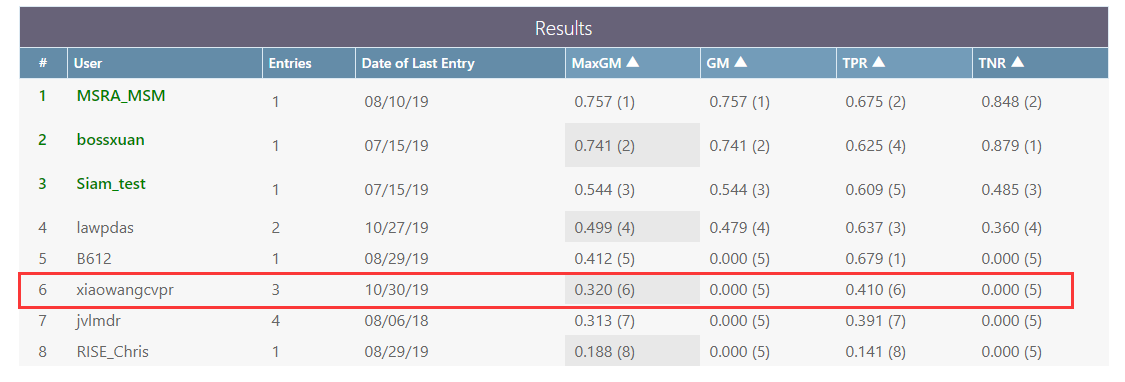save tracking results into csv file for oxuva long-term tracking dataset (from txt to csv)
save tracking results into csv file for oxuva long-term tracking dataset (from txt to csv)
2019-10-25 09:42:03
Official Tools: OxUvA long-term tracking benchmark [ECCV'18] [Github]
Project page: https://oxuva.github.io/long-term-tracking-benchmark/
import os
import numpy as np
import cv2
import time
import oxuva
import pdb # export PYTHONPATH="/home/wangxiao/THOR/long-term-tracking-benchmark-master/python:$PYTHONPATH" # txtPath = '/home/wangxiao/THOR/benchmark/results/OXUVA/Tracker/'
# txtFiles = os.listdir(txtPath) # csv_path = './oxuva_csv_results/' # for index in range(len(txtFiles)): # txtName = txtFiles[index]
# pointPosition = txtName.find('.')
# videoName = txtName[:pointPosition] # preds = np.loadtxt(txtPath + txtName, delimiter=',')
# preds = preds.tolist() # spacePosition = txtName.find('_')
# if spacePosition:
# obj =
# else:
# obj = txtName[spacePosition:spacePosition+] # preds_file = os.path.join(csv_path, '{}_{}.csv'.format(videoName, obj)) # tmp_preds_file = os.path.join(csv_path, '{}_{}.csv.tmp'.format(videoName, obj))
# with open(tmp_preds_file, 'w', encoding='utf-8-sig') as fp:
# pdb.set_trace() # oxuva.dump_predictions_csv(videoName, obj, preds, fp)
# os.rename(tmp_preds_file, preds_file) # pdb.set_trace() import json
import pdb
import cv2
import os
import pandas as pd
resultpath= '/home/wangxiao/tracking_results_oxuva/'
videopath="/home/wangxiao/dataset/OxUvA/images/test/"
videos=os.listdir(videopath)
txtFiles = os.listdir(resultpath) for i in range(len(videos)):
txtName = videos[i] + "_oxuva-baseline.txt"
preds = np.loadtxt(resultpath + txtName, delimiter=',') print("==>> txtName: ", txtName)
xmin=[]
xmax=[]
ymin=[]
ymax=[]
video_ids=[]
obj_ids=[]
frame_nums=[]
presents=[]
scores=[]
video_id=videos[i][:]
if(len(videos[i])==):
obj_id='obj0000'
elif(videos[i][-]==''):
obj_id='obj0001'
else:
obj_id='obj0002'
present='True'
score=0.5
# l=result['res'] imgs=os.listdir(videopath+videos[i]+'/')
imgs = np.sort(imgs)
# pdb.set_trace() image=cv2.imread(videopath+videos[i]+'/'+imgs[])
imgh=image.shape[]
imgw=image.shape[] for j in range(len(imgs)): # pdb.set_trace() x=preds[j][]
y=preds[j][]
w=preds[j][]
h=preds[j][] ## results relative to original image size.
x1=x/imgw
x2=(x+w)/imgw
y1=y/imgh
y2=(y+h)/imgh x1=round(x1,)
x2=round(x2,)
y1=round(y1,)
y2=round(y2,) frame=imgs[j][:] if(frame==''):
frame_num=
else:
frame_num=frame.lstrip('') xmin.append(x1)
xmax.append(x2)
ymin.append(y1)
ymax.append(y2)
video_ids.append(video_id)
obj_ids.append(obj_id)
frame_nums.append(frame_num)
presents.append(present)
scores.append(score) # pdb.set_trace() dataframe=pd.DataFrame({'video_id':video_ids,'object_id':obj_ids,'frame_num':frame_nums,'present':presents,\
'score':scores,'xmin':xmin,'xmax':xmax,'ymin':ymin,'ymax':ymax})
savepath='./oxuva_csv_results/' +videos[i][:]+'_'+obj_id+'.csv'
columns=['video_id','object_id','frame_num','present','score','xmin','xmax','ymin','ymax'] dataframe.to_csv(savepath,index=False,columns=columns,header=None) # pdb.set_trace()
========= Results

==
save tracking results into csv file for oxuva long-term tracking dataset (from txt to csv)的更多相关文章
- 关于视觉跟踪中评价标准的相关记录(The Evaluation of Visual Tracking Results on OTB-100 Dataset)
关于视觉跟踪中评价标准的相关记录(The Evaluation of Visual Tracking Results on OTB-100 Dataset) 2018-01-22 21:49:17 ...
- ogr2ogr: Export Well Known Text (WKT) for one feature to a CSV file
Perhaps you’re looking for this? ogr2ogr -f “CSV” “E:\4_GIS\NorthArkCartoData\UnitedStates\MO_wkt” “ ...
- C# - CSV file reader
// ------------------------------------------------------------------------------------------------- ...
- SQL SERVER – Import CSV File Into SQL Server Using Bulk Insert – Load Comma Delimited File Into SQL Server
CSV stands for Comma Separated Values, sometimes also called Comma Delimited Values. Create TestTabl ...
- Matlab Code for Visualize the Tracking Results of OTB100 dataset
Matlab Code for Visualize the Tracking Results of OTB100 dataset 2018-11-12 17:06:21 %把所有tracker的结果画 ...
- [PowerShell Utils] Create a list of virtual machines based on configuration read from a CSV file in Hyper-V
Hello everyone, this is the third post of the series. . Background =============== In my solution, ...
- Qt Read and Write Csv File
This page discusses various available options for working with csv documents in your Qt application. ...
- HBase import tsv,csv File
一,HBase中创建table 表(liupeng:test)并创建 info ,contect 列簇 hbase(main):258:0> create "liupeng:Test& ...
- Python: Write UTF-8 characters to csv file
To use codecs, we can write UTF-8 characters into csv file import codecs with open('ExcelUtf8.csv', ...
随机推荐
- mybatis的一级缓存与二级缓存
一级缓存 Mybatis一级缓存的作用域是同一个SqlSession,在同一个sqlSession中两次执行相同的sql语句,第一次执行完毕会将数据库中查询的数据写到缓存(内存),第二次会从缓存中 ...
- jQuery绑定事件的四种方式:bind、live、delegate、on
1.jQuery操作DOM元素的绑定事件的四种方式 jQuery中提供了四种事件监听方式,分别是bind.live.delegate.on,对应的解除监听的函数分别是unbind.die.undele ...
- PHP的SPL标准库
1,简介 SPL,全称 Standard PHP Library 中文是 标准PHP类库.是php内置的一些拓展类和拓展接口,其内容包含数据结构.迭代器.接口.异常.SPL函数,文件处理等内容.SPL ...
- Docker 0x01:Docker Container容器技术
目录 Docker Container容器技术 一句话回答什么是容器? 为什么要有容器? 容器技术的影响 容器技术浅谈原理,怎么实现的?为什么能够这样轻量级标准化 难点 容器的标准 花边 Docker ...
- Django 之瀑布流实现
需求分析 现在是 "图片为王"的时代,在浏览一些网站时,经常会看到类似于这种满屏都是图片.图片大小不一,却按空间排列,就这是瀑布流布局. 以瀑布流形式布局,从数据库中取出图片 每次 ...
- pecl安装php扩展
Pecl全称The PHP Extension Community Library,php社区扩展库,由社区编写,维护. 使用pecl方便之处在于我们不用到处找源码包下载编译,配置,不用手动phpiz ...
- qt5.12 解决显示中文乱码问题
在菜单栏 文件->选项,找到文本编辑器 文件编码设置如图 在cpp文件中加入 #pragma execution_character_set("utf-8") 之后就可以 ...
- Show which git tag you are on?
git查看当前代码是在那个tag? reference: https://stackoverflow.com/questions/3404936/show-which-git-tag-you-are- ...
- 转载>>去除inline-block元素间间距的N种方法《重》
一.现象描述 真正意义上的inline-block水平呈现的元素间,换行显示或空格分隔的情况下会有间距,很简单的个例子: <input /> <input type="su ...
- Mysql一些常见语句
Mysql一些常见语句 (1)展示所有的数据库名 SHOW DATABASES (2)选中某一个数据库 USE 数据库名字 (3)查看某一个表的结构 DESC 表名 (4)数据库的创建 CREATE ...
